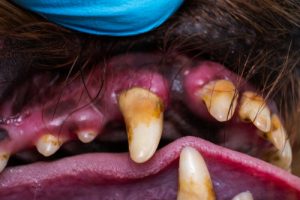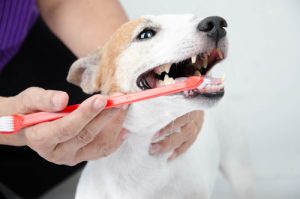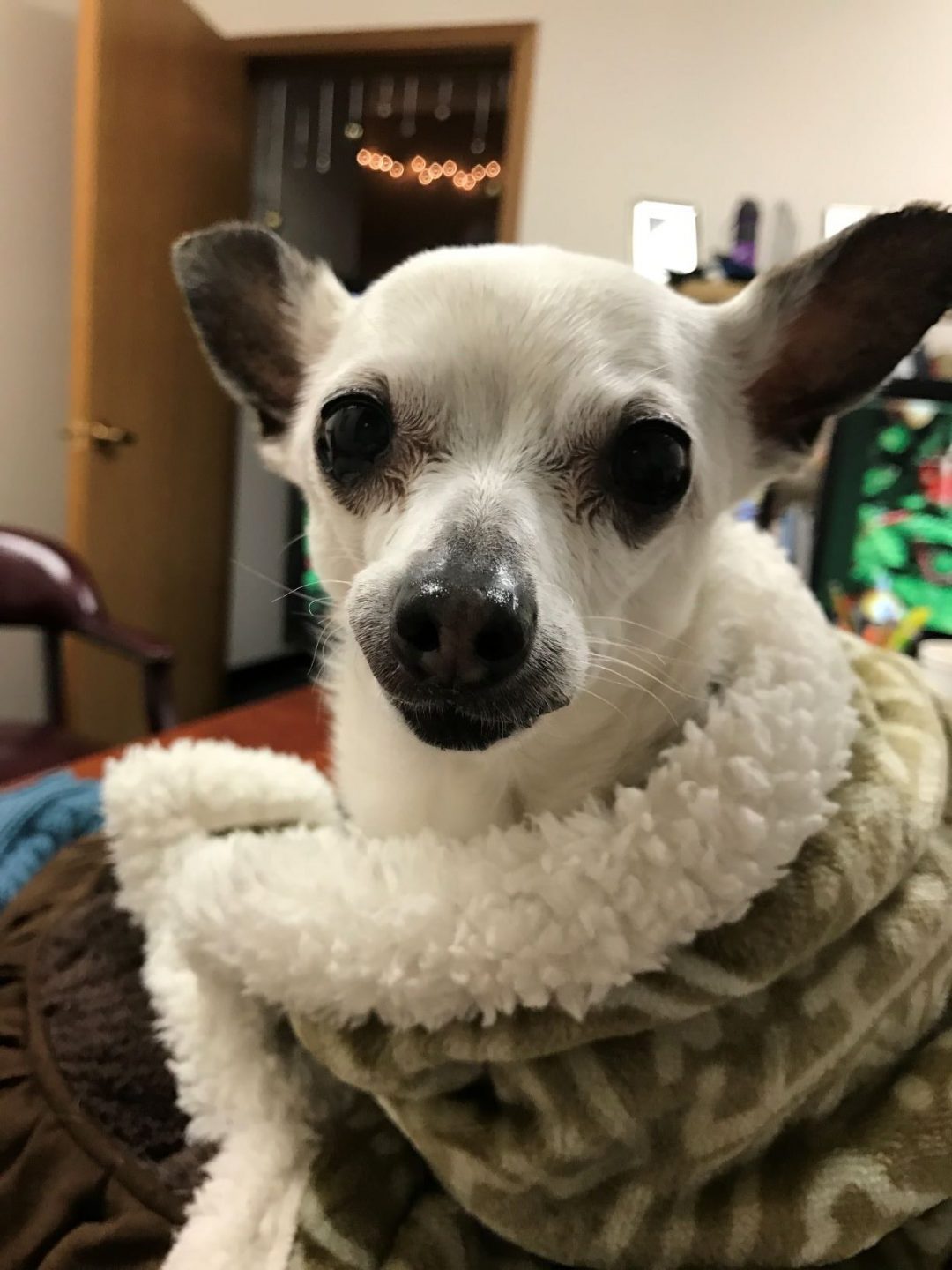February is Dental Health Month for Dogs. Current research says 80% of dogs will show signs of dental disease by the age of three. Only 7% of dog owners brush their dog’s teeth with any regularity.
Maintaining good dental health can contribute to a longer life for your dog! To prove this, I have a story to tell you about my experience in dog dental health.
Button’s Story
A few years ago, I lost a good friend in an unfortunate car accident but gained a fantastic dog. Button was a 15-year-old chihuahua/papillon cross and the sweetest dog I had ever met. I was honored to be the person trusted to care for my friend’s beloved dog.
As soon as I picked Button up, it was clear he needed veterinary care. He smelled awful and had trouble eating. Additionally, I was concerned with his peeing. He dribbled instead of peeing a steady stream. I knew this was a problem that needed immediate attention, so the next day, off to the Vet we went.
After a thorough exam and blood workup, we had a diagnosis and plan of action.
The tests proved his teeth in horrible shape. Advanced tartar had built up. The tartar had caused gingivitis that had advanced to full-blown periodontal disease. He also had an enlarged prostate because he had never been neutered (but that’s another article).
The Heart-Breaking Truth of Periodontal Disease
 Periodontal disease can cause a multitude of health problems. This is especially true for small older dogs.
Periodontal disease can cause a multitude of health problems. This is especially true for small older dogs.
Plaque forms on dog’s teeth like it does on ours. If left unattended, it hardens to tartar. The tartar builds up and irritates the gums. Eventually, it causes the gums to start pulling away from the teeth. The roots are then exposed, leaving gaps that become infected. Abscesses lead to periodontal disease. This disease can be devastating for older dogs with toy breeds being even more vulnerable to this preventable disease.
Button’s blood work proved our suspicions; the bacteria from his mouth had invaded his bloodstream. The tests also showed his heart had enlarged. So, he had developed a heart murmur that was at a dangerous level. Poor little Button smelled foul, almost foul enough you didn’t want to cuddle him. Lucky for him, he was so cute I couldn’t resist, so loved on him despite the smell.
The Vet recommended pulling his teeth. Once pulled, Button would be given strong antibiotics to take care of the infection in his mouth and his bladder. He also needed neutering because of his enlarged prostate. That contributed to his peeing problem. (Not neutering your dog can also cause problems, but that’s another article.)
A Veterinary Dentist did the extractions. Armed with a load of strong antibiotics, we were able to clear up his periodontal disease. It was a long two months of antibiotics twice a day, but Button was a trooper. Soon it was time for another vet visit with a full blood workup.
Button’s tests came back negative for infection. The biggest surprise for me (and the Vet) was the x-ray of his heart. Clearing out the infections had an effect on Button’s heart – it had decreased in size! His heart murmur was down from a 3+ rating to a 2+ rating. It was good news and we were in the home stretch!
Button’s trials made me think about the importance of keeping your dog’s teeth in good shape. We always hear our teeth are the window to our health. Doesn’t it make sense that would apply to dogs as well?
Button was a heart-wrenching lesson on the actual dangers of not taking care of a dog’s teeth. I am convinced his teeth and the neglect they suffered were to blame. He should have been a happy, healthy little dog. But, due to the neglect of his teeth, he faced severe health issues. Due to the complexity of Button’s situation, his Vet used his story and tests to share with her veterinary forums and colleagues. Now I want to share the importance of taking care of your dog’s teeth with you. The reasons why, and how you can do it yourself.
Here’s the scoop:

Research proves healthy teeth and gums will contribute to extending the lifespan of your dog and it’s widely known that 80% of dogs will show some signs of dental disease by the age of three. Small and toy breeds are the most vulnerable to dental problems because of their tiny mouths.
Regular professional care from a veterinarian and daily home care will keep your dog’s mouth healthy. Currently, studies show only 7% of dog owners brush their dog’s teeth.
Fact:
Dogs have two sets of teeth, like humans. Puppies have milk teeth (or baby teeth) that push through at about 3-4 weeks. These will start to fall out around four months old. By six months old, their permanent teeth are present.
How do you maintain your dog’s teeth at home?
 It’s easier when they are puppies, but older dogs can enjoy the process if you are consistent and go slowly. The key is introducing the process slowly and keeping oral care as a general routine for your dog.
It’s easier when they are puppies, but older dogs can enjoy the process if you are consistent and go slowly. The key is introducing the process slowly and keeping oral care as a general routine for your dog.
Here’s a guide to introducing an oral care routine to your dog:
- Baby steps. Start by getting your dog used to you messing with their mouth. Run your fingers over the outside of their mouths, chin, and cheeks. Your dog will get used to you touching there for reasons other than treating.
- Make it fun. After your dog is comfortable with step one, still using only your finger, run it around his cheeks, inside his mouth, and over his gums. At first, your dog may give you strange looks, but make it a play session of sorts, and your dog will think it’s a new game.
- Use the correct tools. Once your dog is comfortable with step two, introduce a dab of veterinary toothpaste on your finger. Let your dog taste it.
- Make it tasty. There are many pet toothpaste options on the market. Most offer delicious flavors your dog will enjoy. If you prefer, you can use a dilution of salt and water instead of toothpaste. Never use human toothpaste; it may upset your dog’s digestion.
- Keep it brief. Keep the oral care sessions brief. You only need a couple of minutes a day for good oral health. Be sure to praise your dog to keep the sessions a positive experience.
Now it’s time to introduce the toothbrush!

- Play can be useful. Puppies can be introduced to the toothbrush by letting them mouth it, but older dogs enjoy that also. Don’t let them chew on it. Licking and mouthing it is a great way to get them used to it.
- Add the tasty. Once your dog is comfortable, add a bit of veterinary toothpaste, or the salt and water dilution, to the brush.
- Slow and steady. Using slow circular motions, introduce the brush to your dog’s teeth and gums.
- Progress, not perfection. Focus on brushing the outsides of the teeth and gums. You’re looking for progress, not perfection right now.
- Gently push on. Over the next few days, increase the number of teeth brushed. Always brush in a circular motion paying attention to the gums.
- Not going for it? You can try using cotton gauze wrapped around your finger if your dog is not receptive to a toothbrush.
Remember, dogs like routines—you’ll want to brush their teeth at least 2-3 times per week.
Make sure praise, reassurance, and treats signal the completion of the routine. Your dog will soon look forward to having his teeth brushed.
As for Button, he lived happily and was quite healthy for another two years. His heart murmur never went away, nor did the enlargement, but it decreased. I want to believe it was due, in part, to healthy food, lots of love, and regular oral care. He lived another two years with me. Sadly, his heart became unhappy, so I held him while he made his way to the Rainbow Bridge. It devastated me and I’ll always miss him, but I’m happy he is reunited with people he loved.
I have three other dogs, two are senior, and one is a youngster. Oral care is a regular part of our health routines. I hope they all live to ripe old ages because of it.
How do your dog’s teeth look? Is oral care a part of your dog’s routine?

